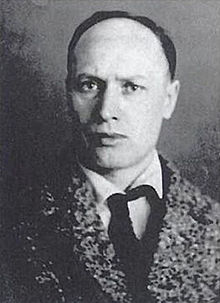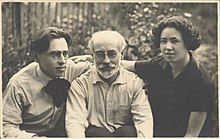Platformism
| Part ofa serieson |
| Platformism |
|---|
 |
Platformismis an anarchist organizational theory that aims to create a tightly-coordinated anarchist federation. Its main features include a commontactical line,a unified politicalpolicyand a commitment tocollective responsibility.
First developed byPeter Arshinovin response to the perceived disorganization of theRussian anarchist movement,platformism proposes that a "general union of anarchists" be established to agitate, educate and organize theworking classes.It advocatesworking withinexistingmass organizations,such astrade unions,in order to transform them into vehicles for asocial revolution.
History
[edit]Precursors
[edit]The roots of platformism go back as far as the organizational principles ofMikhail Bakunin,[1]particularly in his theory of "organisational dualism". Bakunin proposed that anarchists form their own revolutionary organisations that would encourage workers to rebel against the state and capitalism, and once asocial revolutionhad replaced the state with a federation ofvoluntary associations,it would then agitate against any attempted reconstitution of the state by political parties.[2]
The Platform's most direct predecessor was theDraft Declaration of the Revolutionary Insurgent Army of Ukraine,adopted in 1919 by theMilitary Revolutionary Councilof theMakhnovshchina.TheDraft Declarationcalled for a "Third Revolution"against the Bolshevik government, in order to establish a regime offree soviets.[3]It centred theRevolutionary Insurgent Army of Ukraineas the nucleus of this revolution, where the organization's entire membership would carry out the decision-making process.[4]In 1921, the Makhnovists published anotherDeclarationthat proclaimed adictatorship of the proletariatin the form of an anarchist-led trade union system, for whichNestor Makhnohimself was accused ofBonapartism.[5]
Meanwhile, theNabat Confederation of Anarchist Organizations,which had originally been established as a loose-knit organization, developed into a tightly-organized structure with a unified policy and an executive committee, in what a member would later describe as a precursor to platformism.[6]
Formulation
[edit]
After their flight into exile,RussianandUkrainian anarchistsbegan to call for the reorganization of the anarchist movement, considering that chronic disorganization had led to their defeat during theRevolution.[7]Among the anarcho-communists,Peter Arshinovwas the most vocal advocate of reorganization.[8]
On 20 June 1926, theOrganizational Platform of the General Union of Anarchists (Draft)was published inDelo Truda,with an introduction penned by Arshinov.[9]Considering the goal of anarchism to be asocial revolutionthat would create astatelessandclassless society,thePlatformproposed the establishment of a General Union of Anarchists to educate theworking classand raiseclass consciousness.[10]This General Union was to be organised according to the principles oftheoretical unity,tactical unityandcollective responsibility,[11]and would be governed by anexecutive committeethat coordinated collective action and political policy.[12]
Debate
[edit]ThePlatformwas first presented at a meeting of theDelo Trudagroup, with attendees also includingBulgarian,Chinese,FrenchandItalian anarchists.At the meeting, Arshinov introduced the document as a way forward for the international anarchist movement to "marshal its forces".[13]Although supported byNestor Makhno,Arshinov'sPlatformwas opposed by most prominent anarchists at the time.[14]French anarchistsin attendance, led bySebastien Faure,criticised it as Russocentric, considering it unapplicable to the material conditions in France.[15]In the years that followed, Faure'sAnarchist Synthesis,which rejected platformism in favor of a more loose-knit organization, contributed to dividing the anarchist movement into "synthesists" and "platformists".[16]

The Platform's harshest critics includedVolin,Senya FleshinandMollie Steimer,[17]who denounced thePlatformas an attempt to create an anarchistpolitical party,[18]which they feared would inevitably result in the formation of apolice state.[17]Arshinov responded by claiming hisPlatformactually abided by anarchist principles, as it consciously avoidedcoercionand preserveddecentralization.[19]The debate also took a more personal turn as Makhno and Arshinov attacked Volin, which attracted denunciations from other critics of thePlatform,[20]includingAlexander Berkman,who denounced Makhno as amilitaristand Arshinov as aBolshevik.[19]
After years of defending the ideas of Platformism, in the early 1930s, Arshinov joined theCommunist Partyand defected to theSoviet Union,[21]where he would disappear during theGreat Purge.[22]Nestor Makhno himself died in 1934, leaving thePlatformwithout any prominent defenders.[23]Nevertheless, both the opponents and remaining supporters of thePlatformmanaged to reconcile at Makhno's funeral.[24]Volin himself took up the publication of Makhno's memoirs, which were published in the years after his death.[25]
Organizational developments
[edit]During theSpanish Revolution of 1936,a number of revolutionary anarchist hard-liners formed theFriends of Durruti Groupin opposition to the state'smilitarisationof theconfederal militias.[26]After the Revolution wassuppressed,the group publishedTowards a Fresh Revolution,which called for a revolutionary council to reform the militias and bring the economy back under the control of theConfederación Nacional del Trabajo(CNT), which would effectively have dissolved thegovernment of Spain.[27]In the wake of the1944 Bulgarian coup d'état,the Federation of Anarchist Communists of Bulgaria (FAKB) issued its ownPlatform,which argued for a specifically anarcho-communist federation, coordinated by a central secretariat, which would participate in trade unions and prepare for a social revolution.[28]
In 1953, the French anarchistGeorges Fontenispublished hisManifesto of Libertarian Communism,which attacked the prevailing synthesist orientation of the French anarchist movement, becoming the founding document for the Libertarian Communist Federation (FCL).[29]Drawing from aspects of thePlatform,Fontenis'Manifestocalled for an anarchistrevolutionary vanguardto work within existing mass organizations in order to develop amass movement,with the eventual aim of dissolving itself into the movement and achieving a social revolution.[30]In the years that followed, the FCL united together with the North African Libertarian Movement (MLNA) to establish the Libertarian Communist International (ICL), but their suppression by the French state forced the organization's dissolution in 1957.[31]Platformism was revived in France during the events ofMay 68,when theRevolutionary Anarchist Organization(ORA) was founded, although it would remain the minority tendency within the anarchist movement.[32]The formation of the ORA accelerated the establishment of other anarchist federations throughout Europe, such as theAnarchist Federation(AF) in Britain and the Federation of Anarchist Communists (FdCA) in Italy, while the ORA itself would eventually be succeeded by theLibertarian Communist Union(UCL).[33]
Especifismo(English:Specifism) was first developed in 1972 by theUruguayan Anarchist Federation(FAU), with the publication of its textHuerta Grande,which proposed the creation of a unified political policy directly applicable to the material conditions in Uruguay.[34]The collapse of the rulingright-wing dictatorshipstowards the end of theCold Warresulted in the emergence of many otherespecifistagroups throughout Latin America, in a process spearheaded by the FAU.[35]In 2003, theAnarkismo.netwebsite was established by an international network of anarcho-communist organizations, including both Latin Americanespecifistasand European platformists, which publishes news and analysis in a variety of different languages.[36]
References
[edit]- ^Darch 2020,p. 143;Graham 2018,p. 330.
- ^Graham 2018,pp. 330–331.
- ^Schmidt 2013,pp. 61–62.
- ^Schmidt 2013,pp. 62–63.
- ^Darch 2020,p. 75.
- ^Schmidt 2013,p. 66.
- ^Avrich 1971,pp. 238–239;Darch 2020,p. 140;Malet 1982,pp. 163–164, 190;Schmidt 2013,p. 60;Skirda 2002,p. 120.
- ^Avrich 1971,p. 241;Skirda 2002,pp. 122–123.
- ^Darch 2020,p. 143;Skirda 2002,p. 122, 124.
- ^Darch 2020,pp. 143–144.
- ^Darch 2020,p. 143;Schmidt 2013,p. 61;Skirda 2002,pp. 124–125.
- ^Avrich 1971,p. 241;Malet 1982,p. 190;Schmidt 2013,p. 61.
- ^Skirda 2002,p. 124.
- ^Avrich 1971,pp. 241–242;Darch 2020,p. 144;Malet 1982,pp. 163–164, 190–191.
- ^Darch 2020,p. 144;Skirda 2002,p. 124.
- ^Schmidt 2013,p. 63.
- ^abAvrich 1971,pp. 241–242.
- ^Avrich 1971,pp. 241–242;Darch 2020,p. 144;Malet 1982,pp. 190–191;Skirda 2002,pp. 125–126.
- ^abAvrich 1971,pp. 242–243.
- ^Avrich 1971,pp. 242–243;Malet 1982,pp. 190–191.
- ^Avrich 1971,pp. 243;Darch 2020,p. 145;Malet 1982,pp. 163–164, 191.
- ^Avrich 1971,pp. 245–246;Darch 2020,p. 145;Malet 1982,pp. 163–164.
- ^Darch 2020,p. 145;Malet 1982,pp. 164, 191–192.
- ^Malet 1982,p. 164.
- ^Malet 1982,p. 190.
- ^Schmidt 2013,pp. 80–81.
- ^Schmidt 2013,p. 81.
- ^Schmidt 2013,pp. 82–84.
- ^Schmidt 2013,pp. 94–95.
- ^Schmidt 2013,pp. 95–96;Skirda 2002,pp. 171–172.
- ^Schmidt 2013,p. 96.
- ^Schmidt 2013,pp. 96–97.
- ^Schmidt 2013,pp. 97–98.
- ^Schmidt 2013,p. 98.
- ^Schmidt 2013,p. 102.
- ^Schmidt 2013,p. 105.
Bibliography
[edit]- Avrich, Paul(1971) [1967].The Russian Anarchists.Princeton:Princeton University Press.ISBN0-691-00766-7.OCLC1154930946.
- Baker, Zoe (2023). "Organizational Dualism: From Bakunin to the Platform".Means and Ends: The Revolutionary Practice of Anarchism in Europe and the United States.AK Press.pp. 307–346.ISBN978-1-84935-498-1.OCLC1345217229.
- Berry, David (2002).A History of the French Anarchist Movement: 1917 to 1945.Westport, CT:Greenwood Press.ISBN0-313-32026-8.ISSN0885-9159.LCCN2001054702.
- Darch, Colin (2020).Nestor Makhno and Rural Anarchism in Ukraine, 1917-1921.London:Pluto Press.ISBN9781786805263.OCLC1225942343.
- Graham, Robert (2018). "Anarchism and the First International". In Adams, Matthew S.; Levy, Carl (eds.).The Palgrave Handbook of Anarchism.London: Palgrave Macmillan. pp. 325–342.doi:10.1007/978-3-319-75620-2_19.ISBN978-3319756196.S2CID158605651.
- Malet, Michael (1982).Nestor Makhno in the Russian Civil War.London:Palgrave Macmillan.ISBN978-0-333-25969-6.OCLC8514426.
- Schmidt, Michael (2013) [2012].Cartography of Revolutionary Anarchism.Edinburgh:AK Press.ISBN978-1849351386.OCLC881111188.
- Skirda, Alexandre(2002).Facing the enemy: A history of anarchist organisation.Translated by Sharkey, Paul.Oakland:AK Press.ISBN1902593197.OCLC490977034.
- Skirda, Alexandre(2004) [1982].Nestor Makhno–Anarchy's Cossack: The Struggle for Free Soviets in the Ukraine 1917–1921.Translated by Sharkey, Paul.Oakland:AK Press.pp. 274–290.ISBN978-1-902593-68-5.OCLC60602979.
- van der Walt, Lucien;Schmidt, Michael (2009). "Militant Minority: The Question of Anarchist Political Organisation".Black Flame: The Revolutionary Class Politics of Anarchism and Syndicalism.Edinburgh:AK Press.pp. 239–270.ISBN978-1-904859-16-1.LCCN2006933558.OCLC1100238201.
Further reading
[edit]- Arshinov, Peter;Makhno, Nestor;Mett, Ida;et al. (2006) [1926].The Organizational Platform of the General Union of Anarchists.Translated by McNab, Nestor.Delo Truda– via The Nestor Makhno Archive.
- Balius, Jaime (1978) [1938].Towards a Fresh Revolution.Friends of Durruti Group– via The Anarchist Library.
- Fontenis, Georges(1953).Manifesto of Libertarian Communism.Libertarian Communist Federation – via The Anarchist Library.
- Makhno, Nestor;Malatesta, Errico(1927–1930).About the Platform.Translated by McNab, Nestor – via The Anarchist Library.
External links
[edit]- Anarkismo.net- Multilingual anarchist news site run by over 30 platformist and especifist organisations on five continents


